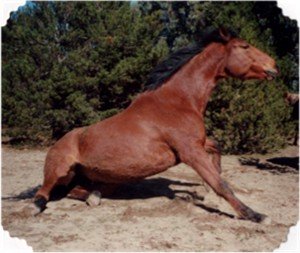Easy Sand Test
Your Best Defense Against Sand Colic
Preforming this easy sand test at home is a simple way to find out if your horse has sand in their gut. Because sand that is passed from the gut is not passed in steady even amounts, it is necessary to do repeat sand tests every other day for two weeks for accuracy. One day you may find no sand and then plenty of sand the next. Be sure to record your results.
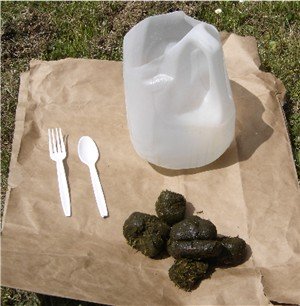 Simple sand test tools
Simple sand test toolsWhen to Run a Sand Test
- On a new horse
- On a horse that hasn’t been tested in a while
- To determine the amount of sand in a horses gut
- To monitor sand removal progress
You will want to collect a clean sample of horse manure, the fresher, the better. Try to sample portions that are not in contact with the ground and make sure they are from the horse that you are want to test for intestinal sand. You will need 6 large balls of horse manure for the sand test. For an easy sand test, collect fresh samples, dry manure is more difficult to work with.
Make a Poo Slurry
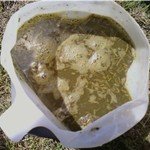 Poo slurry
Poo slurryPlace the balls of manure in a plastic container and fill with approximately 3 quarts of water. Use your spoon, or utensil if choice, to mix the manure. Do not use a dirty stick. You will want to break the manure up into small bits until there are no more chunks left. At this point you will have mixed a poo slurry. As my daughter likes to put it, “canned spinach”….all joking aside, just make sure the manure is thoroughly broken up.
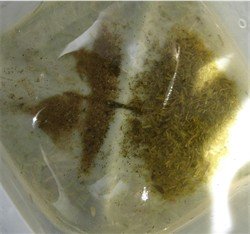 Separate sand (left) from poo (right)
Separate sand (left) from poo (right)Mining for Sand
As the manure is broken up, the sand that it holds will fall to the bottom of the container. Remove the excess the solids off the top of the mixture. A plastic fork works well for this. Allow a few moments for the mixture to settle and then poor the solids off the top, being careful not to pour the sand out. You may need to remove quite a bit of solids off the top to see what you are doing. Finally, you will only be left with the sand at the bottom of the container, which you can measure.
How much sand is OK?……Not Much!
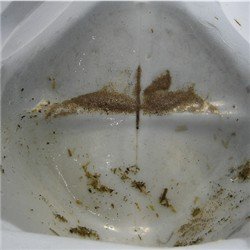 Nearly 1/4 tsp sand found in sample
Nearly 1/4 tsp sand found in sampleSand colic can be deadly. Anything over ¼ teaspoon is considered dangerous. If your horse has lots of sand, or you are suspicious of sand ingestion, or you are just unhappy with what you find, don’t hesitate to contact your vet.
If your horse does have sand in their intestines, you can take control and do something about it. Your horse does not have to suffer from sand colic. This simple easy sand test can help prevent colic. It gives you the power of knowledge!
How to Remove Sand From the Gut
Use a commercially prepared sand remover for horses. These products contain psyllium and can be found at most feed stores or through your veterinarian.
Try to limit sand ingestion by not feeding your horse directly off the ground. Rubber mats or even carpeting placed on the ground can act as a sand barrier. Horses tend to throw their hay around as they rummage for the good bits, so you’ll need a good 8’ by 8’ of ground cover for your horses feeding area.
Use this easy sand test repeatedly as needed, to monitor the progress of sand removal from the gut. To protect your horse from sand colic, feed your horse off the ground and adopt a sand removal maintenance program.
Do you know someone who could use this information? Please share it using the buttons below.
More on Colic in Horses:
Home > Horse Colic > Easy Sand Test
